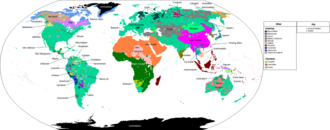List of languages by total number of speakers

This is a list of languages by total number of speakers.
It is difficult to define what constitutes a language as opposed to a dialect. For example, Arabic is sometimes considered a single language centred on Modern Standard Arabic, other authors consider its mutually unintelligible varieties separate languages.[1] Similarly, Chinese is sometimes viewed as a single language because of a shared culture and common literary language.[2] Conversely, colloquial registers of Hindi and Urdu are almost completely mutually intelligible, and are sometimes classified as one language, Hindustani. Such rankings should be used with caution, because it is not possible to devise a coherent set of linguistic criteria for distinguishing languages in a dialect continuum.[3]
There is no single criterion for how much knowledge is sufficient to be counted as a second-language speaker. For example, English has about 450 million native speakers but, depending on the criterion chosen, can be said to have as many as two billion speakers.[4]
There are also difficulties in obtaining reliable counts of speakers, which vary over time because of population change and language shift. In some areas, there is no reliable census data, the data is not current, or the census may not record languages spoken, or record them ambiguously. Sometimes speaker populations are exaggerated for political reasons, or speakers of minority languages may be underreported in favor of a national language.[5]
Ethnologue (2025)
[edit]Ethnologue lists the following languages as having 50 million or more total speakers.[6] This section does not include entries that Ethnologue identifies as macrolanguages encompassing several varieties, such as Arabic, Lahnda, Persian, Malay, Pashto, and Chinese.
The World Factbook (2022)
[edit]The World Factbook, produced by the Central Intelligence Agency (CIA), estimates the ten most spoken languages (L1 + L2) in 2022 as follows:[8]
| Language | Percentage of world population (2022) |
|---|---|
| English | 18.8% |
| Mandarin Chinese | 13.8% |
| Hindi | 7.5% |
| Spanish | 6.9% |
| French | 3.4% |
| Arabic | 3.4% |
| Bengali | 3.4% |
| Russian | 3.2% |
| Portuguese | 3.2% |
| Urdu | 2.9% |
See also
[edit]- Lingua franca
- Lists of languages
- List of languages by number of native speakers
- List of countries by number of languages
- List of countries and territories by official language
- World language
- Languages used on the Internet
- Extinct language
- Official languages of the United Nations
- Geolinguistics
- Language geography
Explanatory notes
[edit]- ^ Modern Standard Arabic (MSA) is not an L1. Arabic speakers first learn their respective local dialect. MSA is acquired through formal education.[7]
- ^ Tagalog and Filipino are defined as two different languages in the ISO 639 standard. Ethnologue considers that Filipino is a standardized variety of the Tagalog language with no speakers.
References
[edit]- ^ Kaye, Alan S.; Rosenhouse, Judith (1997). "Arabic Dialects and Maltese". In Hetzron, Robert (ed.). The Semitic Languages. Routledge. pp. 263–311. ISBN 978-0-415-05767-7.
- ^ Norman, Jerry (1988). Chinese. Cambridge University Press. p. 2. ISBN 978-0-521-29653-3.
- ^ Paolillo, John C.; Das, Anupam (31 March 2006). "Evaluating language statistics: the Ethnologue and beyond" (PDF). UNESCO Institute of Statistics. pp. 3–5. Retrieved 17 November 2018.
- ^ Crystal, David (March 2008). "Two thousand million?". English Today. 24: 3–6. doi:10.1017/S0266078408000023. S2CID 145597019.
- ^ Crystal, David (1988). The Cambridge Encyclopedia of Language. Cambridge University Press. pp. 286–287. ISBN 978-0-521-26438-9.
- ^ a b "What are the top 200 most spoken languages?". Ethnologue. 2025. Retrieved 8 March 2025.
- ^ Arabic, Standard at Ethnologue (27th ed., 2024)

- ^ a b "Most spoken languages in the World". The World Factbook. CIA. Retrieved 2022-01-01.
